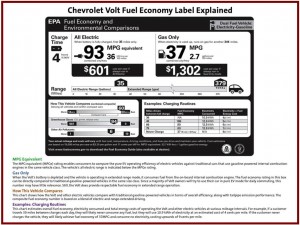
It's an informed label that will take much studying to understand. Consumer behavior is much simpler - how much does it cost me?
Talking green is one thing. Paying for green is another matter entirely, especially when the economy is in tatters. That is the gist of the latest study of consumer attitudes towards alternative powertrain vehicles, the current fad among the well fed political set.
Despite huge increase in the number of alternative vehicles appearing on the market for the next few years – a fivefold increase from 30 hybrid or electric vehicles today, dutifully recorded by AutoInformed – the actual sales of hybrid electric vehicles, “clean” diesel engines, plug-in hybrid electric vehicles, and battery electric vehicles will remain sparse even as fuel prices rise.
To veterans of the automotive ecological wars, the conclusions of the J.D. Power and Associates 2011 U.S. Green Automotive Study released today are, numbingly, familiar. For most consumers cost is the not so invisible hand that drives a free market – even a semi-free one with lavish taxpayer subsidies in place in an attempt by the government to mandate technologies.
The reality is that while research indicates that saving the cost of fuel is overwhelmingly the predominate reason people give for considering a “Green” machine, the initial cost is too high, the payback too long – if there is even one – to translate that hope into an actual purchase of a green machine.
It’s true that the potential environmental benefits are recognized – but more in passing than in purchasing. Consider: 75% of consumers who indicate they might buy a hybrid electric vehicle cite lower fuel costs as a main benefit. In contrast only 50% cite “better for the environment” as a main benefit of these technologically dazzling vehicles.
Even consumers who are not considering an alternative powertrain vehicle recognize the fuel-cost savings “Green” vehicles can offer. However, they cite significant perceived – or actual – impediments to ownership in addition to purchase price, including driving range, increased maintenance costs and compromised vehicle performance. These consumers are far more likely to switch into a more fuel-efficient vehicle powered by a traditional internal combustion engine than an alternative powertrain vehicle according to Power.
“Alternative powertrains face an array of challenges as they attempt to gain widespread acceptance in the market,” said Mike VanNieuwkuyk, executive director of global vehicle research at Power.
“It is the financial issues that most often resonate with consumers, whether it is the higher price of the vehicle itself, the cost to fuel or charge the vehicle, or the fear of higher maintenance costs. The bottom line is that most consumers want to be green, but not if there is a significant personal cost to them,” he said.
According to VanNieuwkuyk, concern about the purchase price of alternative powertrain vehicles—particularly for hybrid electric vehicles—has become even more of an issue in 2011.
Small wonder: At the end of 2010, lavish tax credits from the Energy Policy Act of 2005 for hybrids were phased out.
“Hybrid electric vehicles have been available in the automotive market for more than 10 years, and consumer awareness and understanding of them has grown during that time,” said VanNieuwkuyk.
He acknowledges that concerns about the functionality and performance of hybrid vehicles have disappeared, but vehicle price has now become the primary purchase impediment. Without a tax credit to offset the price premium, as in other people’s money, consumers must absorb all of this additional cost with their money. (As I said, a numbingly familiar economics 101 tenant applied to automotive marketing.)
Although there are also significant price premiums for battery electric vehicles, functional concerns are more likely to limit consideration rates for this powertrain. Driving range and the availability of charging sites away from home are the two concerns cited most often by those not considering this powertrain. This “range anxiety” contributes to the lowest consideration levels of the primary alternative powertrain technologies. (See $5 Fuel Tipping Point for U.S. Electric Car Consideration. Consumer Expectations – Globally – at Odds with EV Realities)
For so called “clean” diesel engines, fuel prices and availability—factors largely out of the control of vehicle manufacturers—have long been impediments to acceptance of the technology. Furthermore, negative perceptions of older diesel-powered vehicles continue to affect perceptions of diesel vehicles, as concerns about emissions and exhaust odor are mentioned frequently.
“Advocates of clean diesel engines tend to be some of the most vocal among consumers who tout the benefits of their chosen technology,” said VanNieuwkuyk. “However, this consumer group is relatively small. Clean diesel technology continues to struggle not only against concerns about cost and perceived fuel availability, but also against the lingering perception that diesel is ‘dirty.’”
Implications for Automakers
Overall, the study reveals interest in alternative powertrain vehicles among a majority of consumers, with perceptions of green vehicles being largely positive. However, converting this interest into actual sales will require concerted efforts to improve the technology and infrastructure while reducing the cost to consumers.
By the end of 2016, Power expects there to be 159 hybrid and electric vehicle models available for purchase in the U.S. market. This is a significant increase from only 31 hybrid and electric models in 2009.
Despite the Power research VanNieuwkuyk falls into a familiar trap here: He claims that automakers, along with government entities and others, have considerable work to do in “educating consumers” as to the true costs and benefits of these technologies.
“Only through promotion and education will significant numbers of U.S. consumers become sufficiently comfortable with both the financial investment and, in some cases, lifestyle changes required to make the leap from traditional vehicles to alternative powertrain vehicles,” said VanNieuwkuyk.
May the invisible hand smite thee for tinkering with the marketplace…

